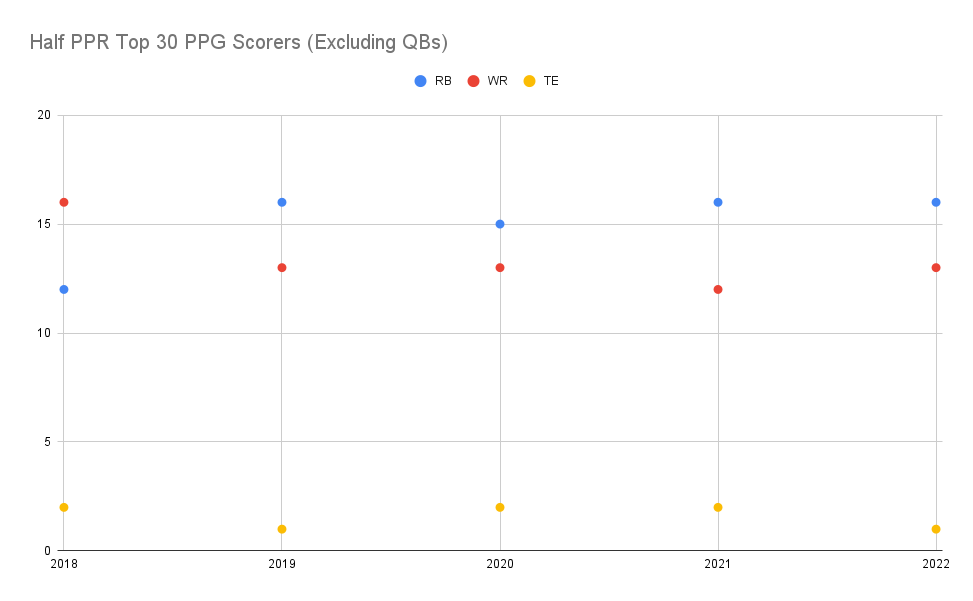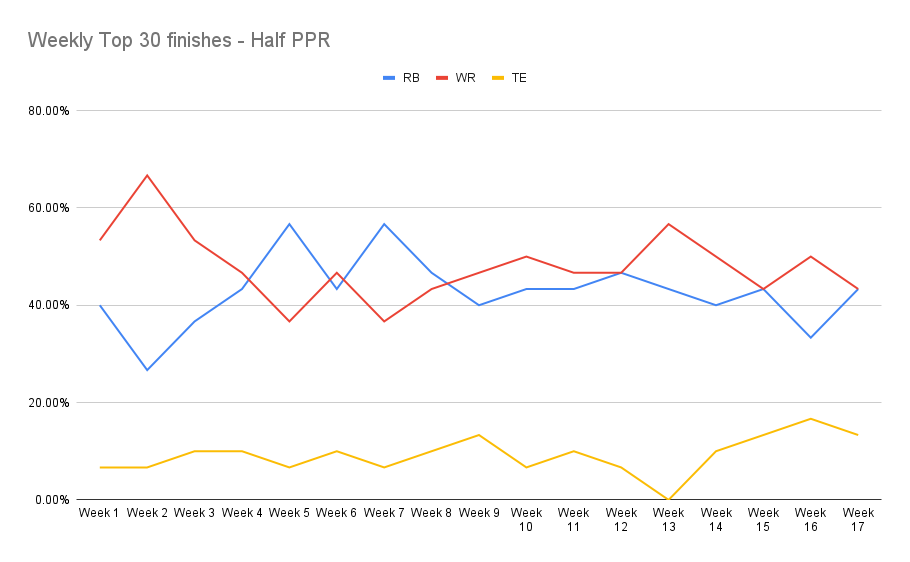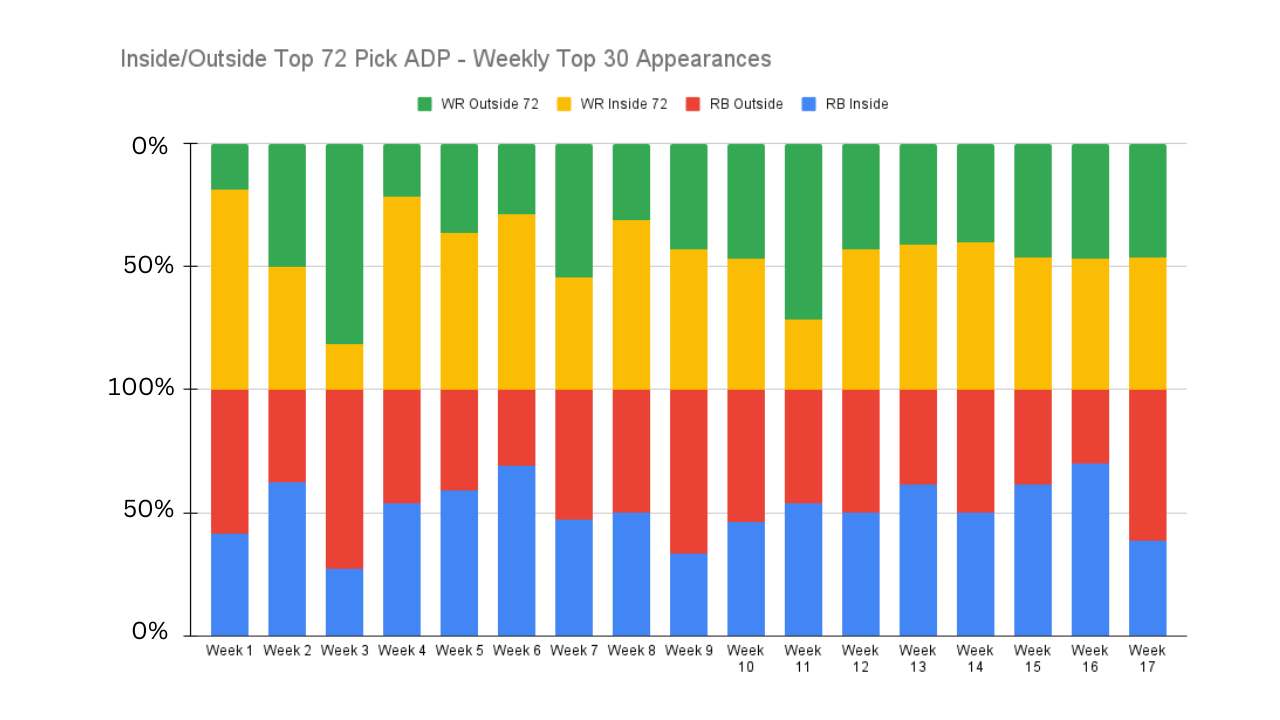The Best Ball Strategy That Doesn't Work

Best Ball season is bigger and better than ever, and thanks to Half Point PPR taking over the world, more and more draft strategies are viable. In 2023 alone we saw a Zero RB team take down the $1,000,000 regular season prize in Best Ball Mania III before a Dual/Bimodal RB roster took home the $2,000,000 overall prize. With the wave of popularity around Best Ball sweeping up more and more people each year, the awareness of micro-strategies like these is becoming more widespread and accepted, but what strategies have a poor record in Best Ball and should be primarily avoided? In this article, we’ll look at one strategy that historically hasn’t improved your chances.
Zero Wide Receiver
The antithesis of Zero RB is Zero WR, a strategy that stems from a belief in early-round running backs being vastly better than the options available later on, while also believing that wide receivers in the later rounds offer enough depth and scoring to get by okay. Zero WR involves drafting at least three running backs in the first six rounds, with other picks spent on tight end or quarterback, no picks spent on a wide receiver and typically being very running back heavy through the first ten rounds.
In Half PPR formats scoring between running backs and wide receivers has been pretty similar over the last five years, with running backs making up more of the top 30 points total points scorers than wide receivers in that time. The table below shows us that and tells us that the end-of-season results aren’t too dissimilar at the very least.

In terms of Best Ball though, weekly results matter greatly so if we move to weekly finishes in 2022, this is what it looks like when we filter for top 30 points scores from non-QB players. We can see that Running Backs made up the majority of the top 30 weekly highest scorers on three occasions compared to 11 for Wide Receivers.

We’re able to make the conclusion that wide receivers are making up the majority of top scores over the course of the season, but there is more nuance to this so next we should figure out where those points are coming from in terms of ADP.

This table shows us that if we dive into the top 30 Weekly Non-QB scorers, remove tight ends, who rarely make an impact and break it down by ADP to represent those inside the top 72 picks in ADP and those outside of that, how often they were contributing big performances. Each bar represents a percentage of the weekly top 30 scorers that a group of players was drafted in.
Running backs who were picked inside the top 72 made up the majority of those inside the top 30 on eight occasions, with running backs picked after pick 72 making up the majority on five occasions, and the two were split on four occasions. That totals up to nine weeks where running backs picked after the 72nd pick either equaled or did better than those drafted highly.
Wide receivers picked inside the top 72 picks made up the majority of wide receivers scoring inside the top 30 on 13 out of the 17 fantasy-relevant weeks, with one week resulting in a tie and three where the wide receivers picked after pick 72 represented the majority. Here it’s far clearer that the wide receivers drafted inside the top 72 consistently performed well.
So far we’ve established that in 2022 wide receivers inside the first six rounds consistently put up bigger points than running backs picked in a similar range, which makes it fair to assume that Zero WR teams who were waiting on wide receivers missed out on difference makers. By examining the weekly points returns, we can see that the latter wide receivers who Zero WR drafters covet weren’t able to break the top-end scoring consistently, making relying on them very tricky. While running backs at the top of the draft are more likely to have legendary seasons and separate from other running backs, spending large amounts of draft capital on the position while ignoring wide receivers, is unlikely to pay off, particularly given running backs are more prone to missing games through injuries than wide receivers.
Using Rotoviz’s Underdog Roster Construction Explorer we can examine how the strategy has faired over Bestball Mania II and III, by adjusting the inputs to show us results based on a team not selecting their WR1 until after round six (pick 72).

As we can see, regardless of how many wide receivers a team took with the rest of their picks, no builds had consistently positive advance rates above 16.7%. In Best Ball, it can pay off to be different and to push back against the consensus, but when a strategy has little evidence it works or has worked in recent times, it’s worth considering whether there are better ways to get unique. Wide receivers are consistently getting pushed up draft boards in recent years and the quality of those left behind isn’t worth building your hard-earned entries around. Micro-strategies like Hero RB or Bimodal RB allow you to take advantage of the elite running backs near the top of the draft and then focus elsewhere while the wide receiver pickings are still good, without overspending early on a position that is year-on-year susceptible to missing games due to injuries.
TLDR: Wide receivers picked inside the top 72 picks scored better than wide receivers outside of the top 72 picks while running backs failed to separate as often. Waiting on wide receivers isn’t the answer.